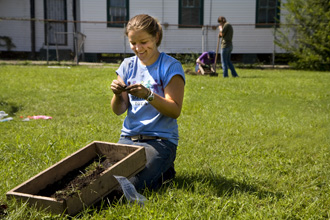Students Dig New Orleans
Archaeological mysteries that intrigued the likes of a real British archaeologist, Howard Carter, who discovered King Tut's tomb in Egypt, and the fictional adventurer, Indiana Jones, who chased the raiders of a lost ark, are being explored by Tulane students in the TIDES course "Loot, Plunder and Pillage: Ethics in Archaeology and the Art Markets."

Briah Fischer, a first-year student from Wausau, Wis., looks for artifacts after sifting dirt in the TIDES course "Loot, Plunder & Pillage: Ethics in Archaeology and the Art Markets." (Photo by Ryan Rivet)
Susann Lusnia, associate professor of classical studies, says that students in the course have shown great interest in learning about the issues archaeologists face.
TIDES (Tulane InterDisciplinary Experience Seminars) are courses designed to introduce students to exciting topics during their first semester at Tulane.
"So far I've had students with interests that range from pre-med to business to engineering to anthropology, history and art," says Lusnia. "The course is an opportunity to sample a discipline that might not otherwise fit their planned course of study."
To develop the course that includes lectures and weekend field trips, Lusnia partnered with University of New Orleans archaeologist Andrea White, who has arranged for hands-on excavation opportunities for the students in the French Quarter and in the Treme neighborhood of New Orleans.
"The Treme project is a partnership with the Christian Fellowship Spiritual Church that owns the property," says White. "The land was once a part of the Pontalba estate, which was donated to the city to become a leprosy hospital and was eventually subdivided to create the residential lots that exist today."
Students attempt to distinguish the time periods of artifacts by sifting through layers of dirt. Historical records and documents also are used to demystify the objects found.
Last year, Tulane students joined archaeologists and students from the University of New Orleans for an excavation in the French Quarter. Among their findings were intact 18th-century deposits including a smudge pit with charred corncobs, pottery items and personal items such as buttons.
